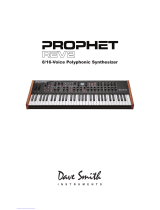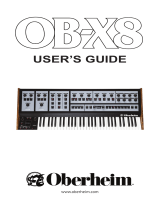Page 1
User instructions for Kenton MIDI retrofit kit for
Yamaha CS-5
These instructions are only for Yamaha CS-5 retrofit kits produced after 18th August 2022
Firmware MSRK5208 or later
Using the MIDI Interface
When you turn on the synthesiser for the first time, you will be in omni-off mode channel 1 for receive - See the
following pages for other factory default settings. When you select a receive channel, this will be stored in memory
and will be remembered for when you subsequently turn on the synth - all parameters listed on the next page are
stored.
If you want to put the synth back to the factory default settings at any time, switch the synth on whilst holding the red
push button pressed - hold for a couple of seconds then release.
Red Push Button
Two modes are available by pushing the red push button during normal playing mode. Before you press the red
button however, make sure that no keys are pressed on the remote MIDI keyboard otherwise the results may be
unpredictable. The key presses can be entered only from the remote MIDI keyboard and may be sent on any MIDI
channel.
1) Setup Mode
For setting MIDI channels and assignments. Give the red push button a short press (half a second) - then release.
Follow this with a key press or sequence of key presses as detailed on page 3. After making a MIDI channel
assignment, you will be immediately returned to playing mode but after making other assignments you will need to
press the ENTER key (Top C) to return to playing mode; this is to enable you to make the multiple key presses
required when re-assigning Sources to Destinations. (N.B. all set-ups are stored in non-volatile memory).
2) Transpose Mode
Press and hold the red push button for about four seconds - then release. A note will sound on the Yamaha CS-5
and continue to sound until you press a key on the remote keyboard. Pressing middle C itself (on the remote
keyboard) gives zero transpose, pressing the G above middle C will transpose up by 7 semitones, or the F below
middle C will transpose down by 7 semitones. You can set any value up to two octaves up or down - settings outside
this range will be ignored. Note that transpose mode cannot be entered from set-up mode. The transpose setting will
not be stored.
Assigning MIDI Controllers
1) To assign MIDI controllers for the destinations available on page 3:
a) press the red push button to enter set-up mode (short press and release)
b) either send the controller you want to assign by moving the knob or slider on your remote keyboard or press a
key on your remote keyboard to select Aftertouch, Velocity, Pitchbend or Off as a source
c) Next press a key on your remote keyboard to select the destination you want to be controlled with it.
d) Then either hit Top C to enter/exit and store, or go back to b) to make another assignment.
2) Note that Aftertouch, Velocity and Pitchbend can only be used as controller sources for any of Aux 1 to 4. Any
other controllers can only be set to CC numbers or OFF
3) Note that “Off” merely stops that particular Aux (or other destination) from responding to any further MIDI
messages. It will stay at the level you last set (until next turned on) and will not be reset to default or any other
value.







